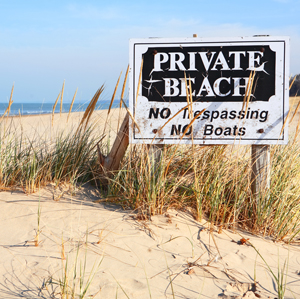 Beachgoers – your rightsEver since you (and your grandparents, and indeed everyone else in the area) can remember, you have all freely accessed the local beach via a convenient road. Then a developer buys up the land over which the road runs, puts up gates and booms, and restricts access to permit holders only. What are your rights?
Beachgoers – your rightsEver since you (and your grandparents, and indeed everyone else in the area) can remember, you have all freely accessed the local beach via a convenient road. Then a developer buys up the land over which the road runs, puts up gates and booms, and restricts access to permit holders only. What are your rights?The High Court recently dealt with just that scenario, concluding (on the application of the local ratepayers’ association) that the general public had a ‘servitudal right of way’, created by “ancient use or immemorial use”, to cross the private land in question – unhindered by gates, booms or the need to obtain a permit.Developers – the danger
Be aware of the dangers here. Your risk is that our law has since Roman times recognised the existence of such unregistered rights of way over private land. Rights, in other words, that you won’t find recorded in the Deeds Office or in the land’s title deeds, but that are nevertheless very much enforceable.
Thus in this case the Court, having before it evidence that the road in question had been used as a public thoroughfare since at least 1795, ordered the developer to restore to the general public its unhindered access over the road.
To add insult to injury, the Court ordered the developer to pay costs on the punitive attorney and client scale.
Right of way users – what you need to prove
Note firstly that we are dealing here with public rights – different rules apply if you are trying to enforce a private right of way.
Secondly, a factor particular to this case which clearly weighed with the Court in reaching its decision, was that the closure of the road subjected pedestrians to a longer walk in “extreme heat” via the alternative route to the beach – which, said the Court, was “without any doubt against the idealistic notions of ‘ubuntu’……(‘humaneness’)”.
To establish a “rebuttable presumption” that a public servitude exists, you will have to show 3 things –
- “That there has been a continuous and uninterrupted activity giving rise to the right by members of the public, whether in general or of a particular locality”;
- “That the owner or successive owners of affected land have not interfered with members of the public carrying out or performing such activity”;
- “That the activity in question existed so long that its origin cannot now be established.” Proof of a minimum of thirty years’ uninterrupted use is required here.
A final note: Although in this case access to a beach was at stake, these legal principles apply to all public rights of way, not just to beaches!
© DotNews, 2005-2013. This article is a general information sheet and should not be used or relied on as legal or other professional advice. No liability can be accepted for any errors or omissions nor for any loss or damage arising from reliance upon any information herein. Always contact your legal adviser for specific and detailed advice.